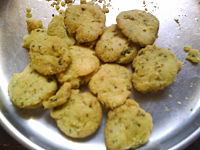Mathri
In today's world, Mathri is a topic that has captured the attention of people of all ages and backgrounds. Over time, Mathri has gained relevance in different areas, from politics and economics to culture and society. No matter if it is a technological advance, a historical event, a public figure or any other aspect, Mathri has managed to significantly impact the way we think and act. In this article, we will further explore the impact and importance of Mathri, as well as its implications in today's world.
 | |
| Alternative names | Mathi |
|---|---|
| Place of origin | India |
| Region or state | Rajasthan |
| Main ingredients | Maida, semolina, dahi (yogurt), ghee |
| Variations | Himachali kadhi |
Mathri (Rajasthani: मठरी, Hindi: मठी, Mathi) is a Rajasthani snack. It is a kind of flaky biscuit from north-west region of India. Once a local delicacy, mathi or mathri as its often called, is now available in almost all sweet shops in India. Similar to Namak para, it is made from flour, water, and, optionally, carom seeds. The creation of this snack was influenced by the need for food that will stay edible for days. The finished products are often stored in big jars at room temperature. Mathri is a popular snack to take along during travels.
Mathri is served with mango, chilli or lemon pickle along with tea. It is also served at weddings and poojas. Masala mathri is a variant of mathri with spices added to make it more crispy. Mathri is also available in different flavours, such as fenugreek leaves (methi), pickle (achari mathri), cumin (jeera) and masala (mixed spices).
It is one of the most popular snacks in North India, and is part of most marriage cooking or religious occasions like Karva Chauth and even as tea-time snack.
See also
References
External links